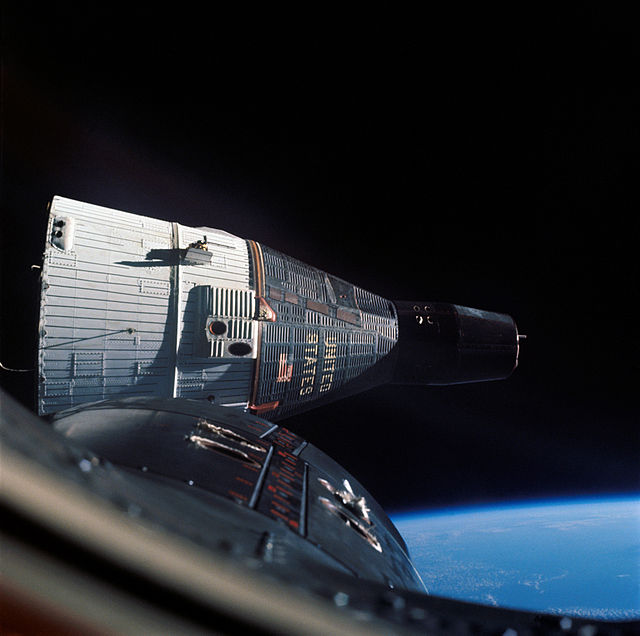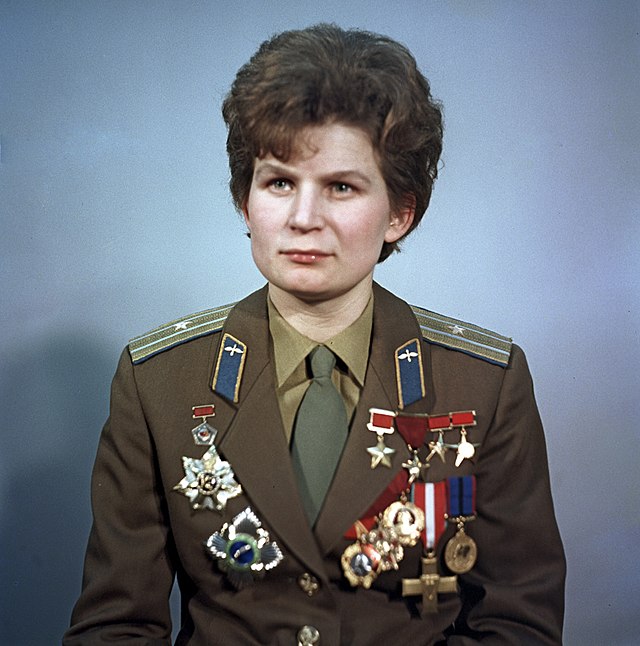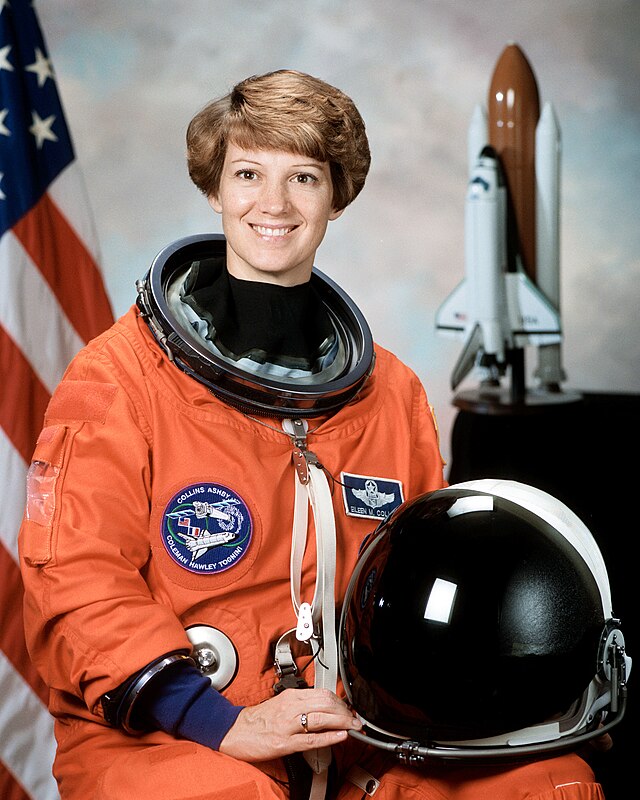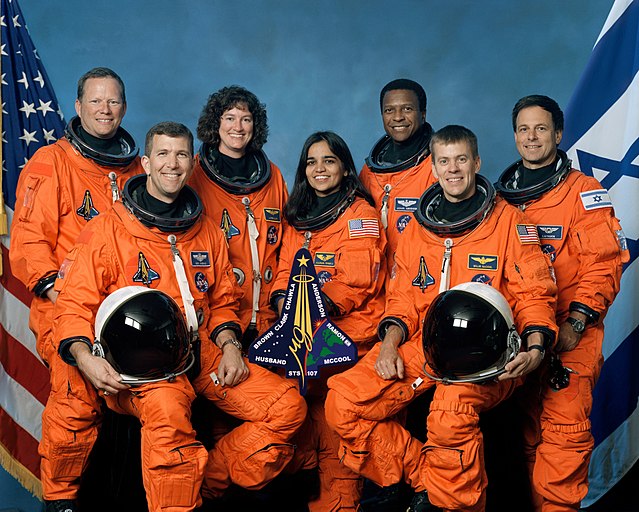Top Qs
Timeline
Chat
Perspective
List of spaceflight records
Extreme benchmarks set off Earth by astronauts, launchers and probes From Wikipedia, the free encyclopedia
Remove ads
Records and firsts in spaceflight are broadly divided into crewed and uncrewed categories. Records involving animal spaceflight have also been noted in earlier experimental flights, typically to establish the feasibility of sending humans to outer space.

The notion of "firsts" in spaceflight follows a long tradition of firsts in aviation, but is also closely tied to the Space Race. During the 1950s and 1960s, the Soviet Union and the United States competed to be the first countries to accomplish various feats. In 1957, the Soviet Union launched Sputnik 1, the first artificial orbital satellite. In 1961, Soviet Vostok 1 cosmonaut Yuri Gagarin became the first person to enter space and orbit the Earth, and in 1969 American Apollo 11 astronaut Neil Armstrong became the first person to set foot on the Moon. No human has traveled beyond low Earth orbit since 1972, when the Apollo program ended.
During the 1970s, the Soviet Union directed its energies to human habitation of space stations of increasingly long durations. In the 1980s, the United States began launching its Space Shuttles, which carried larger crews and thus could increase the number of people in space at a given time. Following their first mission of détente on the 1975 Apollo-Soyuz Test Project, the Soviet Union and the United States again collaborated with each other on the Shuttle-Mir initiative, efforts which led to the International Space Station (ISS), which has been continuously inhabited by humans for over 20 years.
Other firsts in spaceflight involve demographics, private enterprise, and distance. Dozens of countries have sent at least one traveler to space. In 1963, Valentina Tereshkova became the first woman in space, aboard Vostok 6. In the early 21st century, private companies joined government agencies in crewed spaceflight: in 2004, the sub-orbital spaceplane SpaceShipOne became the first privately funded crewed craft to enter space; in 2020, SpaceX's Dragon 2 became the first privately developed crewed vehicle to reach orbit when it ferried a crew to the ISS. As of 2025, the uncrewed probe Voyager 1 is the most distant artificial object from the Earth, part of a small class of vehicles that are leaving the Solar System.
Remove ads
First independent suborbital and orbital human spaceflight by country
Remove ads
Human spaceflight firsts
Summarize
Perspective
This section needs additional citations for verification. (June 2015) |
Note: Some space records are disputed as a result of ambiguities surrounding the border of space. Most records follow the FAI definition of the space border which the FAI sets at an altitude of 100 km (62.14 mi). By contrast, US agencies define the border of space at 50 mi (80.47 km).
Remove ads
Most spaceflights
Summarize
Perspective
Most launches from Earth
- 10 launches
- Frederick W. Sturckow (USA), Space Shuttle and SpaceShipTwo (1998–2024)
Note: The six SpaceShipTwo flights surpass the U.S. definition of spaceflight (50 mi (80.47 km)), but fall short of the Kármán line (100 km (62.14 mi)), the definition used for FAI space recordkeeping.
Most orbital launches overall
- 7 launches
- John W. Young (USA[22]) launched from Earth 6 times (two Gemini, two Apollo Command Module, two Space Shuttle) and from the Moon once (Apollo Lunar Module Ascent Stage) (1965–1983)
- Jerry L. Ross (USA[14]), Space Shuttle (1985–2002)
- Franklin Chang Díaz (Costa Rica/USA*[14]), Space Shuttle (1986–2002)
Most orbital launches from Earth
- 7 launches
- Jerry L. Ross (USA[14]), Space Shuttle (1985–2002)
- Franklin Chang Díaz (Costa Rica/USA[14]), Space Shuttle (1986–2002)
Largest number of different launch vehicles (overall)
- 4 launch vehicles
- John W. Young (USA) – launched from Earth aboard a Gemini, Apollo, and Space Shuttle, and launched from the Moon aboard the Apollo Lunar Module Ascent Stage
Largest number of different spacecraft at launch (from Earth only)
- 3 spacecraft
- Walter Schirra (USA) – launched aboard a Mercury, Gemini, and Apollo (1962–1968)
- John W. Young (USA) – launched aboard a Gemini, Apollo, and Space Shuttle (1965–1983)
- Soichi Noguchi (Japan) – launched aboard a Space Shuttle, Soyuz, and SpaceX Crew Dragon (2005–2020)
- Shane Kimbrough (USA) – launched aboard a Space Shuttle, Soyuz, and SpaceX Crew Dragon (2008–2021)
- Akihiko Hoshide (Japan) – launched aboard a Space Shuttle, Soyuz, and SpaceX Crew Dragon (2008–2021)
- Thomas Marshburn (USA) – launched aboard a Space Shuttle, Soyuz, and SpaceX Crew Dragon (2007–2021)
- Koichi Wakata (Japan) – launched aboard a Space Shuttle, Soyuz, and SpaceX Crew Dragon (1996–2022)
- Peggy Whitson (USA) – launched aboard a Space Shuttle, Soyuz, and SpaceX Crew Dragon (2002–2023)
- Michael López-Alegría (USA) – launched aboard a Space Shuttle, Soyuz, and SpaceX Crew Dragon (1995–2024)
- Michael Barratt (USA) – launched aboard a Soyuz, Space Shuttle, and SpaceX Crew Dragon (2009–2024)
- Barry Wilmore (USA) – launched aboard a Space Shuttle, Soyuz, and Boeing Starliner (2009–2024) (landed in a SpaceX Crew Dragon in 2025)
- Sunita Williams (USA) – launched aboard a Space Shuttle, Soyuz, and Boeing Starliner (2006–2024) (landed in a SpaceX Crew Dragon in 2025)
- Michael Fincke (USA) – launched aboard a Soyuz, Space Shuttle, and SpaceX Crew Dragon (2004–2025)
Largest number of different launch sites
- 3 sites – Any orbital launch
- Neil Armstrong (USA) – Cape Kennedy Air Force Station (aboard a Gemini capsule in 1966), Kennedy Space Center (aboard an Apollo capsule in 1969), Tranquility Base (from the Moon aboard an Apollo Lunar Module, in 1969).
- Buzz Aldrin (USA) – Cape Kennedy Air Force Station (aboard a Gemini capsule in 1966), Kennedy Space Center (aboard an Apollo capsule in 1969), Tranquility Base (from the Moon aboard an Apollo Lunar Module, in 1969).
- Pete Conrad (USA) – Cape Kennedy Air Force Station (twice aboard a Gemini capsule 1965–1966), Kennedy Space Center (twice aboard an Apollo capsule 1969–1973), Ocean of Storms (from the Moon aboard an Apollo Lunar Module, in 1969).
- Alan Shepard (USA) – Cape Kennedy Air Force Station (aboard a Mercury capsule in 1961), Kennedy Space Center (aboard an Apollo capsule in 1971), Fra Mauro (from the Moon aboard an Apollo Lunar Module, in 1971).
- David Scott (USA) – Cape Kennedy Air Force Station (aboard a Gemini capsule in 1966), Kennedy Space Center (twice aboard an Apollo capsule 1969–1971), Hadley Rille (from the Moon aboard an Apollo Lunar Module, in 1971).
- John Young (USA) – Cape Kennedy Air Force Station (now Cape Canaveral Space Force Station, twice aboard a Gemini capsule 1965–1966), Kennedy Space Center (four times, twice aboard an Apollo capsule 1969–1971, twice aboard a Space Shuttle 1981–1983), Descartes Highlands (from the Moon aboard an Apollo Lunar Module, in 1972).
- Gene Cernan (USA) – Cape Kennedy Air Force Station (aboard a Gemini capsule in 1966), Kennedy Space Center (twice aboard an Apollo capsule 1969–1972), Taurus–Littrow (from the Moon aboard an Apollo Lunar Module, in 1972).
- 3 sites – Only orbital launches from Earth
- Sunita Williams (USA) – Kennedy Space Center (aboard a Space Shuttle in 2006), Baikonur Cosmodrome (aboard a Soyuz capsule in 2012), Cape Canaveral Space Force Station (aboard a Starliner capsule in 2024).
- Barry E. Wilmore (USA) – Kennedy Space Center (aboard a Space Shuttle in 2009), Baikonur Cosmodrome (aboard a Soyuz capsule in 2014), Cape Canaveral Space Force Station (aboard a Starliner capsule in 2024).
- 3 sites
- Frederick W. Sturckow (USA) – Kennedy Space Center (four times aboard a Space Shuttle 1998–2010), Mojave Air and Space Port (aboard a Virgin Galactic SpaceShipTwo in 2018), and Spaceport America (also aboard a SpaceShipTwo, five times 2021–2024).
Notes:
- Seven of the twelve Apollo program moonwalkers launched from what was then called Cape Kennedy Air Force Station as part of the Mercury or Gemini programs. On their respective Lunar Landing Mission those seven launched twice. All Apollo Lunar Landing missions that landed on the moon launched from the Kennedy Space Center and when the lunar surface portion of their mission was complete, launched from the surface of the moon to meet up with the Apollo Command Module in lunar orbit.
- SpaceShipTwo flights are suborbital. SpaceShipTwo flights surpass the U.S. definition of spaceflight (50 mi (80.47 km)), but fall short of the Kármán line (100 km (62.14 mi)), the FAI definition used for most space recordkeeping.
Remove ads
Duration records
Summarize
Perspective
Total human spaceflight time by country

Most time in space
The record for most time in space is held by Russian cosmonaut Oleg Kononenko, who has spent 1,111 days in space over five missions. He broke the record of Gennady Padalka on 4 February 2024 at 07:30:08 UTC during his fifth spaceflight aboard Soyuz MS-24/25 for a one year long-duration mission on the ISS.[25] He later became the first person to stay 900, 1,000, and 1,100 days in space on 25 February 2024, 4 June 2024, and 12 September 2024 respectively.[26][27] Gennady Padalka is currently second, having spent 878 days in space. He himself had broken the all-time duration record on 28 June 2015 when he surpassed the previous record holder, cosmonaut Sergei Krikalev, who spent 803 days, 9 hours and 39 minutes (about 2.2 years) during six spaceflights on Soyuz, the Space Shuttle, Mir, and the International Space Station.[28][29][30]
As of 12 December 2025[update],[31] the 50 space travelers with the most total time in space are:
Color key:
- Currently in space
- Active
- Retired
- Deceased
Ten longest human spaceflights
Longest single flight by a woman
NASA astronaut Christina Koch holds the record for the longest single spaceflight by a woman (328 days), returning on February 6, 2020.[37] During Expedition 61, she surpassed NASA astronaut Peggy Whitson's 289 days from 2016 to 2017.
Longest continuous occupation of space
An international partnership consisting of Russia, the United States, Canada, Japan, and the member states of the European Space Agency have jointly maintained a continuous human presence in space since 31 October 2000 when Soyuz TM-31 was launched. Two days later, it docked with the International Space Station.[14][40] Since then space has been continuously occupied for 25 years, 42 days.[14]
Longest continuous occupation of a spacecraft
The International Space Station has been continuously occupied by a Russian and US crew member since 2 November 2000 (25 years, 40 days).[14][40] It broke the record of 9 years and 358 days of the Soviet/Russian Space Station Mir on 23 October 2010.[40]
Longest solo flight
Valery Bykovsky flew solo for 4 days, 23 hours in Vostok 5 from 14 to 19 June 1963.[41] The flight set a space endurance record which was broken in 1965 by the (non-solo) Gemini 5 flight. The Apollo program included long solo spaceflight, and during the Apollo 16 mission, Ken Mattingly orbited solo around the Moon for more than 3 days and 9 hours.
Longest time on the lunar surface
Eugene Cernan and Harrison Schmitt of the Apollo 17 mission stayed for 74 hours 59 minutes and 40 seconds (over 3 days) on the lunar surface after they landed on 11 December 1972.[42] They performed three EVAs (extra-vehicular activity) totaling 22 hours 3 minutes, 57 seconds. As Apollo commanders were the first to leave the LM and the last to get back in, Cernan's EVA time was slightly longer.[42]
Longest time in lunar orbit
Ronald Evans of Apollo 17 mission stayed in lunar orbit for 6 days and 4 hours (148 hours)[43] along with five mice. For the solo portion of a flight around the Moon, Ken Mattingly on Apollo 16 spent 1 hour 38 minutes longer than Evans' solo duration.
Remove ads
Speed and altitude records
Summarize
Perspective
Fastest
The Apollo 10 crew (Thomas Stafford, John W. Young and Eugene Cernan) achieved the highest speed relative to Earth ever attained by humans: 39,897 kilometers per hour (11,082 meters per second or 24,791 miles per hour, about 32 times the speed of sound and 0.0037% of the speed of light).[14] The record was set 26 May 1969, upon atmospheric entry interface after returning from the Moon.[14]
The record for uncrewed spacecraft is held by the Parker Solar Probe at 191.7 km/s, about 1/1600 (or 0.064%) the speed of light, relative to the Sun. This speed was first reached in December 2024.
Farthest humans from Earth
The Apollo 13 crew (Jim Lovell, Fred Haise, and Jack Swigert), while passing over the far side of the Moon at an altitude of 254 km (158 mi) from the lunar surface, were 400,171 km (248,655 mi) from Earth.[44] This record-breaking distance was reached at 00:21 UTC on 15 April 1970.[44]
Highest altitude for crewed non-lunar mission
Polaris Dawn crew Jared Isaacman, Scott Poteet, Sarah Gillis and Anna Menon fired their Crew Dragon Resilience's Draco thrusters on 11 September 2024 at 00:27 UTC, at 15 hours and 4 minutes after liftoff and achieved a record apogee altitude of 874.95 miles (1,408.10 km).[45]
Remove ads
Age records


Earliest-born to reach space
Suborbital flight
- Man – Joe Walker (born 20 February 1921), on X-15 Flight 90 on 19 July 1963 (about 12 minutes.)
- Woman – Wally Funk (born 1 February 1939), on Blue Origin NS-16, on 20 July 2021 (about 10 minutes.)
Orbital spaceflight
- Man – Georgy Beregovoy (born 15 April 1921), on Soyuz 3 on 26 October 1968 (81 orbits in about 4 days.)
- Woman – Valentina Tereshkova (born 6 March 1937), on Vostok 6 on 16–19 June 1963 (48 orbits, about 3 days.)
Youngest
Suborbital flight
- Woman – Anastatia Mayers (aged 18 years, 10 months, and 14 days), on Galactic 02, on 10 August 2023 (about 5 minutes.)
- Man – Oliver Daemen (aged 18 years and 11 months), on Blue Origin NS-16, on 20 July 2021 (about 10 minutes.)
Orbital spaceflight
- Man – Gherman Titov (aged 25 years, 10 months, and 26 days), on Vostok 2 on 6 August 1961 (17.5 orbits, about 1 day.)[14]
- Woman – Valentina Tereshkova (aged 26 years, 3 months, and 10 days), on Vostok 6 on 16–19 June 1963 (48 orbits, about 3 days.)
Oldest
Suborbital flight
- Man: Ed Dwight (aged 90 years, 8 months, and 10 days), on Blue Origin NS-25, on 19 May 2024 (about 10 minutes).
- Woman: Wally Funk (aged 82 years, 5 months, and 19 days), on Blue Origin NS-16, on 20 July 2021 (about 10 minutes).
Orbital spaceflight
- Man: John Glenn (aged 77 years, 3 months, and 11 days), on STS-95 on 29 October 1998 (about 9 days, 20 hours).[46]
- Woman: Peggy Whitson (aged 65 years, 4 months, and 16 days), on Axiom Mission 4 on 25 June 2025 (about 20 days, 2 hours and 59 minutes).[47]
Spacewalk
Youngest
- Woman – Sarah Gillis, (aged 30 years, 8 months, and 11 days), during Polaris Dawn.
- Man – Alexei Leonov (aged 30 years, 9 months, and 18 days), during Voskhod 2.
Oldest
- Man – Michael Barratt (aged 65 years, 2 months, and 8 days), during ISS Expedition 71.
- Woman – Sunita Williams (aged 59 years, 4 months, and 11 days), during ISS Expedition 72.
Remove ads
Spacewalk records
Summarize
Perspective
Most spacewalks (number and duration)
Both of these are the record for the largest total number of spacewalks by a male and a female, and the most cumulative time spent on spacewalks by a male and a female.
- Man – Anatoly Solovyev, 16 spacewalks for a total time of 82 hours, 21 minutes.[48]
- Woman (number) – Peggy Whitson, 10 spacewalks for a total time of 60 hours, 21 minutes.[49][50][51]
- Woman (cumulative time) – Sunita Williams, 9 spacewalks for a total time of 62 hours, and 6 minutes.[52][53]
Most spacewalks during a single mission
- 7: Anatoly Solovyev, during Expedition 24 on the Soviet/Russian space station Mir, in 1997–98. (Two were internal "spacewalks" inside a depressurized module.)
- 7: Andrew Morgan, during his first spaceflight on board the ISS for Expedition 60/61/62 in 2019–2020, he spent 45 hours and 48 minutes outside the station.
Longest spacewalks
- Man – Cai Xuzhe and Song Lingdong, 9 hours 6 minutes, during the Shenzhou 19 mission on 17 December 2024, as they installed space debris protection devices on the exterior of the Tiangong Space Station.[54]
- Woman – Susan Helms, 8 hours 56 minutes, along with James Voss on an ISS assembly mission during Shuttle mission STS-102 on 11 March 2001. The spacewalkers were delayed early in their excursion when a device to help hold an astronaut's feet to the shuttle's robot arm became untethered,[55] and Voss had to retrieve a spare from storage on the exterior of the station's Unity module. After about six hours of work, the pair reentered Space Shuttle Discovery's airlock.
Greatest distance from a spacecraft during a spacewalk
- All-time (and while on a planetary body[56]): 7.6 kilometers[57]: 1144 (4.7 miles, 25,029 feet[58]), Apollo 17, Gene Cernan and Harrison Schmitt, EVA-2, December 12, 1972. During their second of three moonwalks, Cernan and Schmitt rode the Lunar Roving Vehicle to geological station 2, Nansen Crater, at the foot of the South Massif. As all spacewalks not occurring on a planetary body (the Moon) have involved short maximum distances from the spacecraft (see below), this remains the furthest distance that humans have traveled away from the safety of a pressurizable spacecraft, during an EVA of any type.
- Orbital flight: about 100 meters (or 330 feet), Bruce McCandless, STS-41-B, February 7, 1984. With the exception of six Manned Maneuvering Unit (MMU) sorties in 1984 and a test of the Simplified Aid For EVA Rescue (SAFER) in 1994, all other orbital spacewalks have involved a safety tether, anchoring the spacefarer to the spacecraft at a short distance. Of all spacewalks to date, Bruce McCandless' first test of the MMU established an orbital EVA distance record from a spacecraft which remained unbroken by later untethered EVAs.[59]
Remove ads
Animal records
Summarize
Perspective
First animals in space
The first animals to enter space were fruit flies launched by the United States in 1947 aboard a V-2 rocket to an altitude of 68 miles (109 km).[60] They were also the first animals to safely return from space.[60] Albert II, a rhesus monkey, became the first mammal in space aboard a U.S. V-2 rocket on June 14, 1949, and died on reentry due to a parachute failure. The first dogs in space were launched 22 July 1951 aboard a Soviet R-1V. "Tsygin" and "Dezik" reached a height of 100 km (62 mi) and safely parachuted back to Earth.[61]: 21
First animal in orbit
Laika was a Soviet female canine launched on 3 November 1957 on Sputnik 2. The technology to de-orbit had not yet been developed, so there was no expectation for survival. She died several hours into flight. Belka and Strelka became the first canines to safely return to Earth from orbit on 19 August 1960.
First Hominidae in space
On 31 January 1961, through NASA's Mercury-Redstone 2 mission the chimpanzee Ham became the first great ape in space.[62]
Longest canine single flight
Soviet space dogs Veterok (Ветерок, "Light Wind") and Ugolyok (Уголёк, "Ember") were launched on 22 February 1966 on board Cosmos 110 and spent 22 days in orbit before landing on 16 March.
First animals beyond low Earth orbit
An assortment of animals including a pair of Russian tortoises, as well as wine flies and mealworms flew around the Moon with a number of other biological specimens including seeds and bacteria on a circumlunar mission aboard the Soviet Zond 5 spacecraft on 18 September 1968.[60] It had been launched by a Proton-K rocket on 14 September.[60]
Zond 5 came within 2,000 kilometres (1,200 mi) of the Moon and then successfully returned to Earth, the first spacecraft in history to return safely to Earth from the Moon.[60]
Remove ads
Notable uncrewed or non-human spaceflights
Summarize
Perspective
Remove ads
See also
- First images of Earth from space
- Human presence in space
- List of crewed spacecraft
- List of cumulative spacewalk records
- List of International Space Station spacewalks
- List of Mir spacewalks
- List of spacewalkers
- List of spacewalks 2000–2014
- List of spacewalks and moonwalks 1965–1999
- List of spacewalks since 2015
- Manned Maneuvering Unit
- Omega Speedmaster
- Simplified Aid For EVA Rescue
- Space suit
- Suitport
- Timeline of space exploration, list of firsts in space exploration
Remove ads
Notes
- Mikkelsen was born in the United Kingdom, but is now a citizen of Norway. She will wear the flag of Norway on her spacesuit during the spaceflight.[19]
- Wang was born in China but lives primarily in Svalbard and since 2023 is also a citizen of Malta and Saint Kitts and Nevis through their golden visa programs. He will wear the flag of Malta on his spacesuit during the spaceflight.[20]
Remove ads
References
External links
Wikiwand - on
Seamless Wikipedia browsing. On steroids.
Remove ads


















































